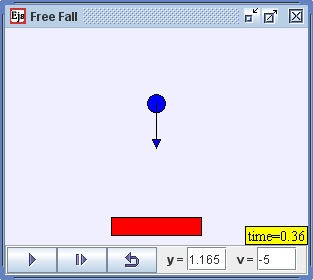

We continue our study of the numerical solution of ordinary differential equations by studying dynamical models that appear in upper-division physics classes. Although some of these models have simple analytic solutions, many do not. Studying and analyzing the EJS implementation of a models is, in fact, similar to doing a laboratory experiment and often provides us with a novel perspective on the behavior of the system.
This week's models will also introduce EJS 3D drawing components.
Free Fall models a ball that is dropped near the surface of Earth. Newton's second law states that a force F produces an acceleration a that is proportional to the mass m of the falling object.
F = ma .
A freely falling object is acted on by a constant downward gravitational force if we ignore air resistance. Because this gravitational force F is constant and because it is proportional to the mass of the falling object, all objects near Earth fall with the same constant downward acceleration g = 9.8 m/s2. In the Free Fall model, the ball's speed is reduced by a constant factor at every floor collision. All motion takes place in the vertical (y) direction to keep this first Ejs example as simple as possible.
The following dynamical models will be discussed in class.
Additional models may be be posted for self-study.
The Free Fall 3D Model was created by Wolfgang Christian using the Easy Java Simulations (EJS) version 4.1 authoring and modeling tool. You can examine and modify a compiled EJS model if you run the model (double click on the model's jar file), right-click within a plot, and select "Open Ejs Model" from the pop-up menu. You must, of course, have EJS installed on your computer.
Information about Ejs is available at: <http://www.um.es/fem/Ejs/> and in the OSP comPADRE collection <http://www.compadre.org/OSP/>.